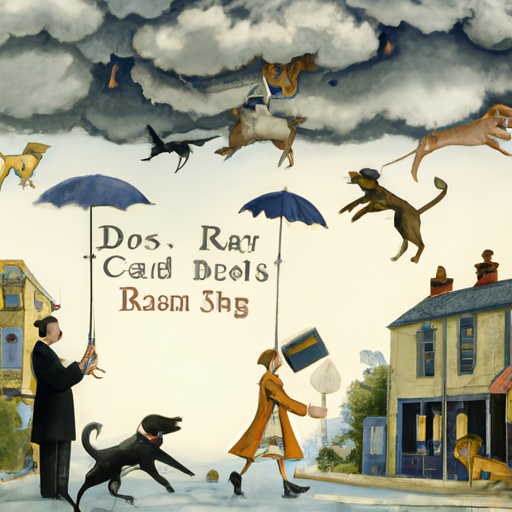“`markdown
Where Did The Saying “Raining Cats and Dogs” Come From?
As you delve into the world of idioms, you’ll often find yourself wondering about their origins. Today, let’s uncover the history of one of the most curious phrases in the English language – “raining cats and dogs”.
Understanding Idioms
As a caregiver, you’re used to helping others navigate their world. Just as you guide them, I’m here to guide you through the intriguing world of idioms.

An idiom is a phrase or expression that has a figurative or sometimes literal meaning that differs from its literal interpretation. For example, when we say it’s “raining cats and dogs,” we don’t mean that cats and dogs are falling from the sky, but rather it’s raining heavily.
Origin Theories
The phrase “raining cats and dogs” has been a part of the English language for hundreds of years, and its exact origin is unknown. However, there are a few theories that historians and linguists have proposed over the years.
-
Norse Mythology: Cats were associated with the goddess Freyja, who was in charge of the weather. Dogs, on the other hand, were often seen as the hounds of Odin, the god of storms. Hence, heavy rain might have been metaphorically described as it’s “raining cats and dogs”.
-
Medieval England: In the 17th century, the roads in England were poor and would become muddy and flooded in heavy rain. This could have led to drowned rats, and sometimes even cats and dogs, which gave the impression that it had rained these animals.
-
Greek Expression: The Greek expression “kata doksa”, which means contrary to expectation, might have been misinterpreted as “cataduexa”, implying a shower of animals or things.
| Theory | Origin |
|---|---|
| Norse Mythology | Cats and dogs associated with gods of weather |
| Medieval England | Poor roads flooding, drowning animals |
| Greek Expression | Misinterpretation of “kata doksa” |
Linguistic Evolution
The phrase first appeared in literature in 1651 in Richard Brome’s comedy, “The City Wit or The Woman Wears the Breeches”. Over time, the phrase evolved and was popularized, eventually becoming part of everyday language.
Cultural Impact
The phrase “raining cats and dogs” has transcended linguistic boundaries and has been translated and used in various cultures around the world. It also appears frequently in popular media, adding to its familiarity and usage.
- Spanish: “Está lloviendo a cántaros” (It’s raining pitchers)
- French: “Il pleut des cordes” (It’s raining ropes)
- German: “Es regnet in Strömen” (It’s raining in streams)
Frequently Asked Questions (FAQ)
1. Are there other animal-related weather idioms?
Yes, indeed. Phrases like “it’s raining pitchforks” or “it’s raining cats and dogs and pitchforks” are also used to describe heavy rain.
2. Why are idioms important in language?
Idioms add color and depth to language, allowing us to express complex ideas in a concise manner. They also provide insight into the culture and history of a language.
3. Are there similar phrases in other languages?
Yes, many languages have their own unique ways of describing heavy rain, often using interesting and creative metaphors.
4. When did the phrase become popular?
While the phrase first appeared in literature in the 17th century, it became more popular and widely used in the 19th and 20th centuries.
5. Is the phrase still used today?
Yes, “raining cats and dogs” is still used to describe heavy rain, especially in English-speaking countries.
By now, you should have a deeper understanding of the phrase “raining cats and dogs”. Just as you care for and guide others, I hope this guide has helped you navigate the world of idioms. Keep exploring, and remember, every idiom has a story worth discovering.
“`



